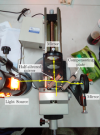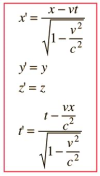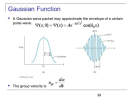I’ll put together an analysis and we can shred it for the purpose of answering this most fundamental of questions! We will get to the truth!
Damn! I love this forum!

So, for those folks not up on the whole Relativity thing, and the Lorentz transform, the background is this:
In the 1800s a scientist called Maxwell built upon the work of Faraday (and a number of other scientists of the day), to unify Electricity and Magnetism and come up with a set of wave equations that could be used to define the properties of Electromagnetic waves.
The work was total genius, and introduced the current conceptual model of the "EM" wave:

There was just one problem! Waves are understood to propagate through a medium, and the wave equations that define the wave motion always define motion relative to that medium.
Maxwell's equations didn't explicitly define the medium, but they did define something related: the speed of EM waves relative to that medium would always be constant - specified by the electrical and magnetic permittivity of the medium:
In this equation c is the speed, μ is the magnetic permittivity, and ε is the electric permittivity.
Both permittivities for free space had already been measured, and in empty space, c was predicted to be the speed of light we know today (186000 miles/second or 3e8 m/s).
This in itself was not startling to anybody, but a number of scientists of the day wanted to complete the theory by discovering the medium through which light was propagating. A number of experiments were attempted, but none were definitive until a US scientist called Michelson perfected the concept of an interferometer that would measure the "aether" as the expected medium was called:

Its way of detecting the effects of the aether was actually simple: measure the interference pattern generated by the two split beams of light, and then rotate the whole apparatus by 45%.
If there were any relative motion of this medium relative to the interferometer, then the interference pattern would change when the interferometer was rotated.
The reason was that if the speed of the light wave was fixed relative to the medium/aether and the interferometer was moving relative to the aether, then the paths to/from the two mirrors would take different times for each beam. By rotating the interferometer by 45%, you could offset the effects of any movement - changing the amount of time each beam took to bounce off the mirrors.
When Michelson and his friend Morley did the experiment, it failed. Not just once, but always.
Scientists all over the world then tried it, and Michelson spent the rest of his life repeatedly trying it. Even I did it in Physics Lab (and it didn't work for me either)!
Nobody was able to detect the aether or any movement through it. They tried different orientations, different rotations, but they never got a shift in the interference pattern.
An Irish scientist called Fitzgerald proposed that there must be some kind of compression/contraction happening as a result of moving through the aether, and two of the best scientific minds of the day, Poincare and Lorentz, took this idea and ran with it - developing what are today called the Lorentz Transforms:

Originally, these transforms were meant to specify the compression of the measurement apparatus due to its movement through the aether.
Lorentz concluded that this compression was due to special behavior of a magical new particle that had just been discovered - the Electron... (Nobody really came up with a better explanation for years - even though the properties of the electrons were being investigated and didn't seem to be causing the contraction.)
It wasn't until a young Einstein proposed, over 10 years later, that there was no aether, and that the Lorentz transforms were universal, that things started to get surreal:
The consequence of Einstein's proposal was that without an aether/medium, light would always be measured as traveling at the same speed regardless of the relative motion of the light and any/all observer(s).
It also meant that the recently formulated vector-based mechanics that separated motion into components, aligned to a set of basis dimensions, did not apply to light: No matter which angle you measured it from, it would always be seen to travel at the speed of light.
Now, another implication - that even Einstein seemed to forget about - was that anything traveling at the speed of light would not experience either time or the universe through which it travelled - since due to the Lorentz equations, both time and space would be reduced to zero.
Most physicists will scoff that, "Einstein said that nothing can ever reach the speed of light" - without thinking about the fact that light can...
Actually if Lorentz holds,
nothing with any mass can be accelerated up beyond the speed of light, because, its apparent mass would reach infinity, preventing any further acceleration. But light is the creature that caused the problem in the first place (and light is generally accepted to be massless)...
Now, shortly after Einstein re-interpreted the Lorentz transforms, a German scientist called Minkowski - a total mathematical genius - proposed a geometric way of representing some of the implications of the new Relativity.
This new geometric model was called Spacetime and essentially expanded the usual concept of graphing things against time to include our 3D world, time, and the effects of the Lorentz transform. This new 4D relativistic spacetime was invaluable for interpreting the implications of the new Relativity which were both mind-blowing and surreal - the most celebrated of them being the "Twin Paradox" referenced above by
@Archaea which says that if one twin accelerated off in a spaceship and then came back, he would have aged less than the twin who stayed home and never experienced the same acceleration.
Not wishing to be outdone, Minkowski and his buddies than proposed that this 4D relativistic spacetime was not just a model, but was actually the reality in which we live, and that we are just moving too slowly to notice.
By doing-so, it introduced as "reality" the concept that time is actually another dimension.
After initially resisting, Einstein accepted this spacetime model and used it in General Relativity (which really just tries to unify all forms of acceleration - including spaceships and the result of gravity - into a coherent model).
I'll stop there with the history, but it leads in to my first question for
@Archaea:
In your model, does the aether exist (and we have just not been able to detect it yet), or does light obey Einstein's
theory that implies that it does not obey Newtonian/Galilean/Vector-based dynamics?
Or, do you have a model that transcends these concepts?
(For reference, Einstein's Relativity is still just a theory, and there are still many folks shooting at it!)











